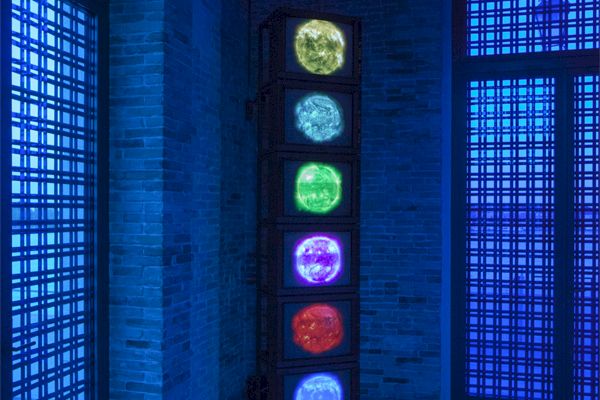BMW Art Guide by Independent Collectors
Prima Materia at Punta Della Dogana
François Pinault Foundation - Venice, Italy

After a microcosmic Grand Tour of the contemporary art world, my feet grew weary pounding the wet gravel and palazzo floors of the Venice Biennale. In search of a more permanent fixture in the city of art I made my way to Punta della Dogana. Occupying the spectacular point where the Grand and the Giudecca Canals converge, this exquisitely restored museum presents site-specific commissions and long-term exhibitions assembled from the François Pinault collection. With a rolling programme, the Pinault Foundation enters into a game of synergy with neighbouring collections, visiting artists and a global audience. Thus, contemporary art thrives in Venice, even when the colossal presence of La Biennale rolls out of town for the winter.

Amid a seasonal downpour, Philippe Parreno’s canopy of lights beckoned me to seek shelter in the exhibition "Prima Materia". Echoing desolately in the foyer, the unrelenting drips of Dominique Gonzalez-Foerster’s sound environment marked the transition from the soggy outside world to a dystopian urban-patio mise-en-scène in the next room. Here, Ryan Trecartin and Lizzie Fitch’s immersive ‘sculptural theatre’ is sprawled languorously across the enormous space, filling it with the trappings of bourgeois leisure and an incessant stream of attention-deficit characters. The calibre of artists on show and the scale of the projects enabled by the Pinault Foundation immediately demonstrate a finger placed resolutely on the art world pulse. Impressive presentations by the likes of Theaster Gates, Sherrie Levine and Llyn Foulkes spark dialogues with new commissions and are equally at home within the extensive collection as in any major biennial.
Sensitive restoration by master architect Tadeo Ando allows the city’s legendary light to permeate the building; viewing apertures in the upper level onto ‘the Cube’ below reveal the wild dense thickets on Zeng Fanzhi’s immense canvases groping for its source. This vast project space at the heart of the museum gives invited artists free rein for a full year. In an adjacent space, a stifling white-hot laboratory of light by Loris Gréaud has likewise been supported by the Foundation. The importance placed on providing initiatives which allow both visiting artists and a general audience to enter into a dialogue with the collection and its setting is a common value of the BMW Art Guide by Independent Collectors.

In the central nave, the light and life breathed back into the building is mirrored in the calm, elemental order of seminal works from the Mono-Ha and Arte Povera movements which have a strong representation in the collection. In the upper level, fluid conversations between medium and environment continue, reclaiming attention from magnificent views out of half-moon windows. Roni Horn’s solid glass casts in washed-out hues of blue and blue-green, gently frosted by the casting process function like gleaming basins of canal water plucked straight out of a Canaletto. They evoke the import/export industries once centred on this very spot in the city and demonstrate how visual culture has superseded them.
If "Prima Materia" is the basis for any magnum opus, then the Foundation finds its parallel in the alchemist’s Ouroboros: in connecting with its own genesis, it enables the circuitous reception and production of transformative contemporary art. As the sun sets upon La Biennale for another two years it is reassuring to know that the François Pinault Foundation remains, year round: a permanent beacon for contemporary art in the city of light.
Kate Andrews is an Edinburgh-based writer, curator and founder of "JaAliceKlarr projects"; a cross-disciplinary curatorial collaboration.
Photos by: © Palazzo Grassi, ph: ORCH orsenigo_chemollo; © Thomas Mayer